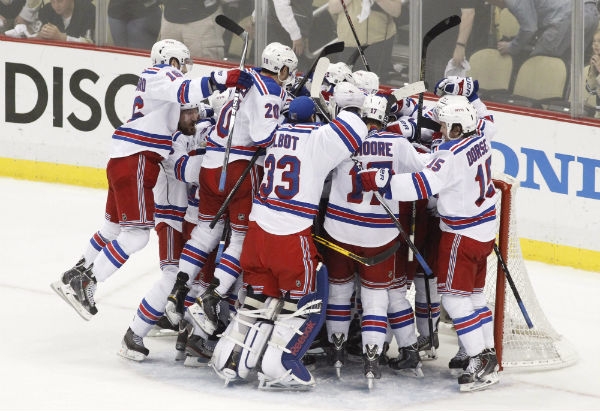It seems like yesterday that the Rangers were running away with the Atlantic Division, securing home ice advantage throughout the playoffs in the process. This was just two seasons ago, and the Black and Blueshirts built a reputation for making lives difficult on opponents. They had a relentless two-man forecheck. They hit everything that moved. They blocked every shot on net. They had stellar goaltending. But they fell short, didn’t even make it to the Stanley Cup Finals.
You’ve heard the rumblings: That team was overachieving. After all, they weren’t even a 50% possession team and they were well above league-average for PDO (basically puck luck). It was a team that dressed Mike Rupp and Stu Bickel on a regular basis. It was a team that saw the bottom line and bottom pairing be lucky to get eight minutes a night. They were a flawed team. Easy to love, but flawed.
Fast forward two years, and we have a very similar situation. The Rangers are in the Eastern Conference Finals facing an opponent that is a perceived underdog (Vegas had the Habs as a favorite, but pretty much everyone who follows hockey had the Rangers as the favorite). The fans can taste the Cup Finals. But these are not your 2012 Rangers.
These Rangers roll four lines at even strength without hesitation. Rick Nash gets –on average– two more minutes per game at even strength than any member of the fourth line. This team rolls three pairings without hesitation. John Moore isn’t glued to the bench the way Bickel and Steve Eminger were.
Under John Tortorella, the premise was north-south hockey and hit everything that moved without sacrificing defensive position. Under Alain Vigneault, it’s an east-west game using speed to generate neutral zone turnovers.
The Rangers were second among Eastern Conference playoff teams in puck possession, but were dead last in PDO among all playoff teams, Eastern Conference or Western Conference. The Rangers were the favorites in 2012, but a “dark horse” this year. Of course, “dark horse” is used loosely. In fact, anyone with a #fancystats degree —including us— thought the Rangers would be incredibly dangerous. Of course I picked them in February to go to the Cup Finals on Puck Daddy (can’t find the link anymore, but I did I swear), but I just wanted to pat myself on the back for that one.
Perhaps the biggest difference is the scoring power. In 2012 the Rangers had one player that could be counted upon regularly for goals: Marian Gaborik. This year they don’t have any 40-goal scorers, but they have scoring depth up and down the lineup. Depth is what got them through droughts by Rick Nash, Brad Richards, Martin St. Louis and Derek Stepan. Depth is what helped them deal with an injury to Chris Kreider, barely.
The goaltender remains the same, 66% of the defense remains the same, 50% of the forwards remains the same. Glen Sather traded or let go some core pieces to bring in some faster, more skilled players. The gamble –for now– has paid off: Two Eastern Conference Finals appearances in three seasons.
These Blueshirts are not your 2012 Blueshirts. They’ve forged a new identity. An identity that states simply: Speed kills. Having the best goaltender in the world playing to a .934 SV% doesn’t hurt either.
Of course, as Suit said, it’s Stanley Cup of bust. This is their window to win.
Share:
More About:Playoffs

